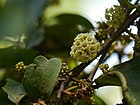Note: This is a project under development. The articles on this wiki are just being initiated and broadly incomplete. You can Help creating new pages.
Anogeissus latifolia - Dhava
Dhava is a small to medium-sized, deciduous tree growing up to 20 metres, occasionally to 35 metres, tall. The bole can be unbranched for up to 15 metres. The tree is often harvested for its gum and tannins. It also yields a good quality wood and is planted in soil stabilization programmes.
Uses
Wound healing, {{Uses|Skin diseases}, Diabetes, Anaemia, Hemorrhoids [1]
Parts Used
Chemical Composition
Common names
| Language | Common name |
|---|---|
| Kannada | dhinduga, dindaga, dindlu |
| Hindi | dhau, dhawda, dohu |
| Malayalam | malakanniram, vellanaga |
| Tamil | vellai-nagai, ekariyamaram, vellainakam |
| Telugu | chirumaanu, sirimaanu, thirumaanu |
| Marathi | NA |
| Gujarathi | NA |
| Punjabi | NA |
| Kashmiri | NA |
| Sanskrit | dhava, dridhataru, madhuratvacha, nanditaru, pishachavriksha, shushkanga |
| English | Dhawa |
, [2]
Properties
Reference: Dravya - Substance, Rasa - Taste, Guna - Qualities, Veerya - Potency, Vipaka - Post-digesion effect, Karma - Pharmacological activity, Prabhava - Therepeutics.
Dravya
Rasa
Kashaya (Astringent)
Guna
Laghu (Light), Rooksha (Dry)
Veerya
Sheeta (cold)
Vipaka
Katu (Pungent)
Karma
Pitta, Kapha
Prabhava
Habit
Identification
Leaf
| Kind | Shape | Feature |
|---|---|---|
| Simple | Opposite or sometimes alternate | estipulate; petiole 5-15 mm, slender, grooved above, glabrous; lamina 2.5-18 x 1.7-9 cm, elliptic, elliptic-oblong, suborbicular, or oblong-obovate, base obtuse, round, cuneate or acute, apex obtuse, emarginate or mucronate, margin entire, glabrous, subcoriaceous; lateral nerves 4-11 paired, pinnate, prominent beneath, arched towards the margin, intercostae scalariform, prominent. |
Flower
| Type | Size | Color and composition | Stamen | More information |
|---|---|---|---|---|
| Bisexual | axillary globose heads | Pale yellow | 10 | peduncle puberulous; pedicel reduced or absent; calyx tube 2 winged, 3-5.5 mm long, produced above the ovary, villous inside, teeth 5, ovate-triangular, to 1 mm long; stamens 10, in 2 series, exserted, 1.5-3 mm long; anthers small; ovary inferior, 1-celled, densely tomentose; ovules 2, pendulous; style 2-3 mm long, thickened at base, villous; stigma simple. |
Fruit
| Type | Size | Mass | Appearance | Seeds | More information |
|---|---|---|---|---|---|
| A drupe | 6 - 8 mm across | greenish-yellow, compressed, puberulous, circular; wings 2, margin entire or slightly undulate, beaked; seed one, obovate. | {{{6}}} |
Other features
List of Ayurvedic medicine in which the herb is used
Where to get the saplings
Mode of Propagation
How to plant/cultivate
Season to grow
Soil type
Propagation
Commonly seen growing in areas
Photo Gallery
References
External Links
- Ayurvedic Herbs known to be helpful to treat Wound healing
- Ayurvedic Herbs known to be helpful to treat Diabetes
- Ayurvedic Herbs known to be helpful to treat Anaemia
- Ayurvedic Herbs known to be helpful to treat Hemorrhoids
- Herbs with Bark used in medicine
- Herbs with Gum used in medicine
- Herbs with Heartwood used in medicine
- Herbs with common name in Kannada
- Herbs with common name in Hindi
- Herbs with common name in Malayalam
- Herbs with common name in Tamil
- Herbs with common name in Telugu
- Herbs with common name in Sanskrit
- Herbs with common name in English
- Habit - Tree
- Index of Plants which can be propagated by Seeds
- Index of Plants which can be propagated by Cuttings
- Herbs that are commonly seen in the region of Tropical area
- Herbs
- Plants of western ghats
- Combretaceae






